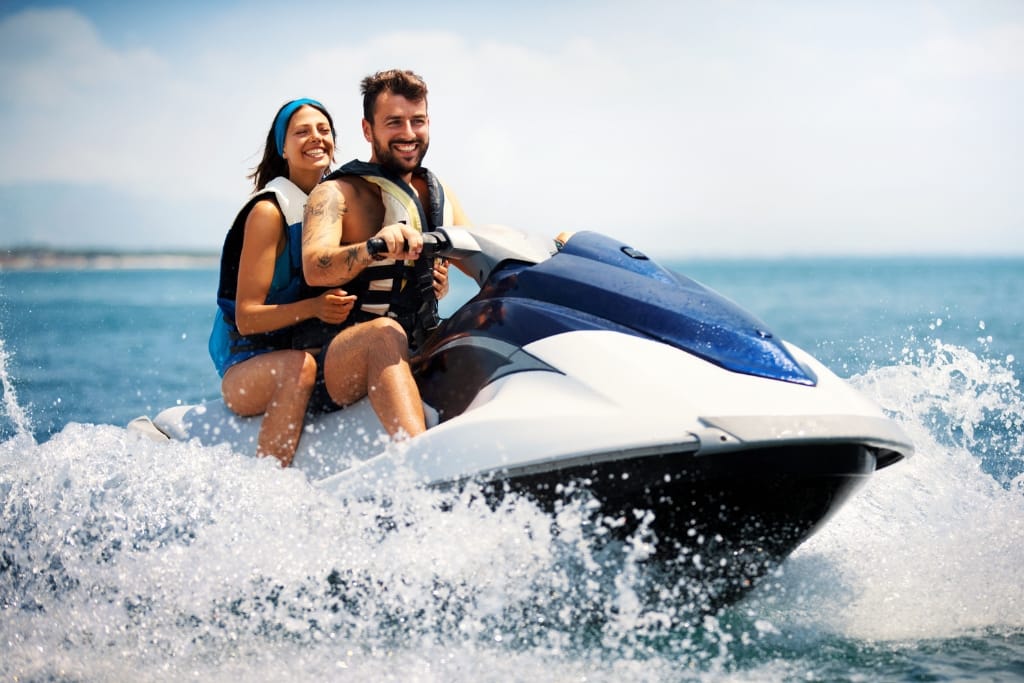Riding a jet ski combines the thrill of speed with the serenity of gliding across open water, offering an unforgettable experience for both beginners and seasoned riders.
However, without the right preparation and knowledge, it’s easy to encounter challenges that can dampen the fun.
By understanding common pitfalls and learning essential tips, you can ensure a safe and enjoyable ride every time.
Read on to discover how to make the most of your jet ski adventure while avoiding mistakes that many riders face.
1)) Wear A Life Jacket
Wearing a life jacket is one of the most critical safety measures when riding a jet ski.
It provides essential buoyancy to keep you afloat in case you fall into the water, which can happen unexpectedly even to experienced riders.
Modern life jackets are designed to allow freedom of movement, ensuring comfort without compromising safety.
Selecting a properly fitted, Coast Guard-approved life jacket is important to ensure maximum effectiveness.
Prioritizing this equipment ensures your safety and gives you the confidence to fully enjoy your jet skiing experience.
2)) Learn Controls Beforehand
Understanding the controls of a jet ski beforehand is essential to ensure a safe and enjoyable ride.
Familiarizing yourself with the throttle, handlebars, and braking mechanisms will help you feel more confident and in control on the water.
Many jet skis also come with advanced features, such as reverse controls or learning mode, which are designed to assist new riders.
Taking the time to review the owner’s manual, attend a safety course, or even practice basic maneuvers in a calm area can make a significant difference.
Gaining this knowledge upfront builds your skills and makes your jet skiing experience smoother and more enjoyable.
3)) Use A Safety Lanyard
Using a safety lanyard is a simple, yet vital step to ensure your safety while riding a jet ski.
The lanyard connects you to the jet ski’s engine cut-off switch, which immediately stops the engine if you fall off.
This safety feature prevents the jet ski from continuing to move without you, reducing the risk of accidents and making it easier to retrieve.
Attaching the lanyard securely to your wrist or life jacket before starting your ride is an important habit to develop.
This precaution enhances your safety and provides peace of mind, allowing you to focus on the thrill of the ride.
4)) Start At Low Speed
Starting at a low speed is crucial for maintaining control and building confidence as you get accustomed to the jet ski.
Accelerating too quickly can surprise new riders, potentially leading to a loss of balance or control.
Beginning at a moderate pace allows you to feel how the jet ski responds to throttle inputs and maneuvers, allowing you to practice steering and stability.
This approach is especially important in crowded areas or near shorelines, where careful navigation is needed.
Taking it slow at the start promotes safety, enhances your control, and sets the stage for a more confident and enjoyable ride as you progress.
5)) Check Weather Conditions
Checking weather conditions is a vital step to ensure your jet skiing experience is both safe and enjoyable.
Sudden changes in weather, such as strong winds or storms, can create dangerous situations on the water.
Make it a habit to review forecasts for wind speed, wave height, and visibility before heading out.
Calm and clear conditions are ideal, especially for less experienced riders. Be vigilant throughout your ride for any signs of changing weather patterns.
Staying informed about the weather helps you avoid unnecessary risks and ensures a worry-free adventure on the water.
6)) Avoid Sharp Turns
Avoiding sharp turns is an essential part of staying safe on a jet ski, especially for beginners and in crowded waters.
Making abrupt or aggressive turns at high speeds can lead to loss of balance, potentially throwing you off the jet ski or causing a collision.
Instead, focus on executing smooth, controlled maneuvers to maintain stability and ensure a better grip on the handlebars.
Practicing gradual turns is particularly important when navigating around other watercraft, swimmers, or obstacles.
Prioritizing controlled movements enhances your safety and allows for a more enjoyable and stress-free ride.
7)) Maintain Proper Distance
Maintaining proper distance between your jet ski and other watercraft, swimmers, or obstacles is critical for ensuring the safety of everyone on the water.
Crowded waterways can be unpredictable, and keeping a safe margin allows you ample time to react to sudden changes, such as unexpected turns or stops of others around you.
Always adhere to local regulations regarding minimum distance and speed limits, as these rules are designed to prevent accidents.
Being mindful of your surroundings and creating enough space helps protect yourself and others while promoting a safer and more enjoyable environment on the water.
8)) Watch For Other Vessels
Staying alert and watching for other vessels is one of the most important responsibilities while operating a jet ski.
Boating traffic can vary from slow-moving sailboats to fast motorboats, making the water a dynamic and, at times, unpredictable environment.
It's essential to keep a watchful eye on your surroundings, including vessels approaching from different directions or those that may not be following proper navigation guidelines.
Be particularly cautious in busy areas or near docks where traffic is denser.
Practicing vigilance ensures your safety and contributes to a more harmonious experience for everyone on the water.
9)) Don’t Overload The Jet Ski
Avoiding overloading the jet ski is crucial for maintaining proper balance, performance, and safety on the water.
Every jet ski has a specified weight capacity that should not be exceeded, as overloading can affect the craft’s stability, steering, and ability to maneuver efficiently.
Carrying too many passengers or packing excessive gear increases the risk of capsizing or engine strain, which could lead to dangerous situations.
Always check the manufacturer's guidelines and ensure the weight is distributed evenly.
Respecting weight limits helps keep your ride safe and ensures a smooth and enjoyable experience for everyone involved.
10)) Keep Balance Steady
Maintaining a steady balance on a jet ski is essential for both safety and control during your ride.
Proper posture, such as keeping your feet planted firmly on the footrests and your knees slightly bent, helps you absorb any movement from waves or turns.
Distribute your weight evenly to prevent the craft from leaning too heavily on one side, which could result in tipping over.
It’s also important to make smooth, deliberate movements, rather than sudden shifts, to avoid destabilizing the jet ski.
Keeping your balance steady ensures a safer and more enjoyable experience on the water while boosting your confidence as a rider.
11)) Follow Local Regulations
Following local regulations is a fundamental aspect of responsible jet ski operation.
These rules are put in place to ensure the safety of all waterway users and protect the surrounding environment.
Regulations can include speed limits, no-wake zones, designated riding areas, and restrictions near wildlife or swimming zones.
Familiarizing yourself with these laws before heading out helps you avoid penalties and ensures you're acting as a considerate and responsible rider.
Adhering to local guidelines creates a safer atmosphere for everyone and promotes better enjoyment of the water for all.
Conclusion
Mastering safe jet ski practices is essential for protecting yourself, others, and the environment while maximizing your enjoyment on the water.
From avoiding sharp turns to maintaining balance and following local regulations, each guideline plays a critical role in fostering a safer and more fulfilling experience.
By adopting these habits, you'll not only enhance your skills as a rider but also contribute to a respectful and harmonious atmosphere on the waterways, ensuring years of fun and adventure await.
Download Our Free E-book!







